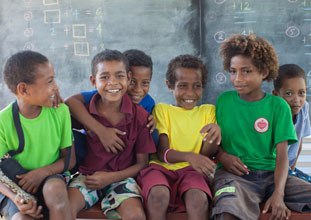The importance of educating girls
Almost 130 million girls worldwide are denied an education. Many barriers prevent girls from going to school and realising their potential, including poverty, gender inequality, and war and conflict. A lack of education can negatively impact girls’ lives, and the welfare of entire societies.
What educating girls means
Girls with a quality education have greater opportunities to create a better future for themselves and their families. But how does education benefit more than just the individual? Here are a few ways everybody benefits when girls go to school and have access to a quality education:
Economic empowerment: Girls who finish secondary education earn almost twice as much as those with no education at all. They’re more likely to have better employment opportunities, and be able to contribute more to their families and communities.
Health and wellbeing: Secondary school education reduces rates of child marriage and early childbearing. Girls who finish high school are also more likely to know how to combat preventable diseases and have the ability to make decisions about their own health and their families’ health. Secondary education can also reduce the risk of intimate partner violence.
Breaking the poverty cycle: Girls who receive a quality education gain the knowledge and skills needed to secure stable jobs with higher incomes, and live financially independent lives. They can provide a better life for their families breaking the cycle of poverty that has existed for generations.
Promoting gender equality: Education plays an essential role in challenging discriminatory views that keep girls and women behind. It promotes equality and equips girls with the knowledge to advocate for their rights. Educated girls have improved opportunities and are more likely to lead better lives.
What are the barriers to girls’ education?
Girls need the opportunity to go to school and learn, yet about 130 million girls today are still denied an education.
Some of the common obstacles preventing girls from accessing an education include:
Poverty: The cost of education can prevent children living in developing communities from going to school. Even where there are no school fees, families may not be able to afford the cost of school supplies such as uniforms, school bags and textbooks ·
Cultural factors: Traditional beliefs and practices in some communities can discourage or prevent girls from attending school. Education for girls may not be seen as a priority or may not be valued; instead, girls are expected to leave school early and take on domestic roles or look after younger siblings.
Lack of infrastructure: Poor or inadequate facilities such as classrooms, toilets, libraries or playgrounds can deter girls from attending school. Schools that lack proper toilets and sanitary facilities, for example, can be extremely uncomfortable for girls during menstruation. Girls attending schools without proper toilets often go to forests and bushes nearby, which puts their safety at risk.
Long distances to school: Families living in poverty whose homes are in rural and remote areas are often far from schools. They may lack transport options to get their children to school. They may fear for the safety of their children, particularly their daughters, having to walk long distances to school.
ChildFund Australia’s commitment to girls’ education
ChildFund is working with families, communities, and our local partners to make sure that girls are in school and can finish their education.Initiatives include:
- providing children with learning and school materials such as school bags, uniforms, stationery and books;
- helping to get girls back in school when they have left, by monitoring children’s attendance and when a child starts and leaves school;
- providing schools with learning materials and resources such as reading and exercise books, and mathematic kits;
- training teachers to develop engaging, interactive lessons focused on improving literacy and numeracy skills;
- building or renovating preschools and primary schools, including improving libraries, classrooms, and water and sanitation facilities such as toilets;
- providing bicycles and helmets to help girls living far away to get to school safer;
- providing children with disabilities with the equipment they need to learn, such as hearing aids; and
- empowering girls to become leaders as peer educators. This includes providing equipment and tutoring materials so peer educators can support younger students falling behind in literacy and numeracy.
How you can help
1. Donate to ChildFund Australia’s education appeal, which aims to get more girls in school and graduating!
2. Buy a Gift for Good: For many families, stationery and notebooks are unaffordable. By buying a school supplies set , you could provide a girl with the essential items they need for a successful year of learning, along with a schoolbag to carry them in!












